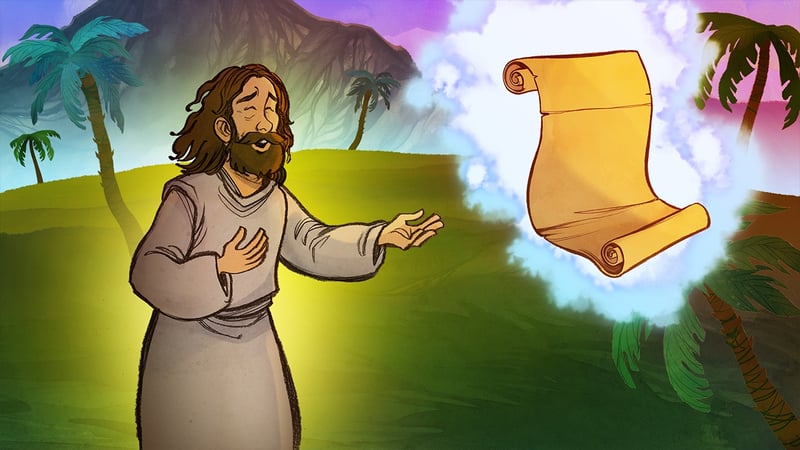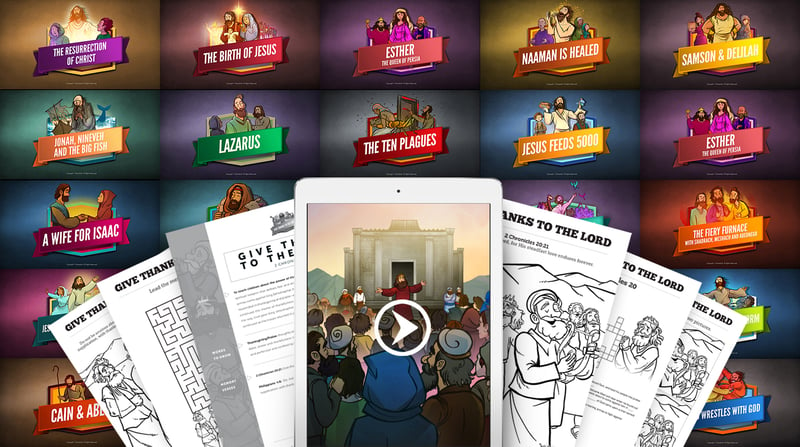


"The ability to draw and communicate visually can no longer be seen as optional."
– Bette Fetter, Author
"The basic rule of storytelling is ‘show, don’t tell.’"
– Julianna Baggott
"A picture is worth a thousand words."
– Unknown
"I hear and forget. I see and remember."
– Confucius
"If one wants to reach younger people at an earlier age to shape their minds in a critical way, you really need to know how ideas and emotions are expressed visually."
– Martin Scorsese

As Sunday School teachers, how we teach is just as important as what we teach. Imagine trying to communicate to your children about the majesty of a mountain without ever letting them see a picture or video of one. Or imagine trying to teach your children about love without telling them a story that brings this concept to life.
Visuals help our children see with their eyes, while stories help them see with their minds. And when these two come together, your children's' ability to learn skyrockets!
In this article, we will examine the power of visual storytelling in the classroom. But before we do, consider the following five facts:
Approximately 65% of the population are visual learners. – Mind Tools, 1998
Although only 10% of students are auditory learners, 80% of instruction is delivered orally. – University of Illinois Extension, 2009
Visual aids in the classroom improve learning by up to 400% – 3M Corporation, 2001.
Research shows that our brains have a natural ability to remember facts told in a story better than facts provided in a list. [1]
God has chosen to reveal himself through the Bible, the greatest story ever told.
[1] Speer, N. K., Reynolds, J. R., Swallow, K. M., & Zacks, J. M. (2009). Reading Stories Activates Neural Representations of Visual and Motor Experiences. Psychological Science, 20(8), 989–999. doi:10.1111/j.1467-9280.2009.02397.x

Look at the lilies of the field and how they grow. – Jesus
As Jesus traveled the region of Galilee, teaching, proclaiming and healing, he soon found himself atop a hill surrounded by a great multitude. It was there that Jesus delivered the most famous sermon ever recorded: The Sermon on the Mount (Matthew 5-7).
This sermon is noteworthy for both its content and its style - what Jesus taught and how he taught. Jesus taught by leveraging the power of visual storytelling. He taught with images that stuck with his audience, images as powerful today as they were over 2000 years ago. The Sermon on the Mount provides any Sunday School leader with a powerful teaching blueprint to follow.
Sunday School lessons are life-changing; there is no subject more important than the Good News of Jesus Christ. But how we teach is as important as what we teach. To maximize our teaching effectiveness, leveraging the power of visual storytelling is not optional.
As we explore the exciting example of Jesus, imagine how your Sunday School could be transformed by applying his approach to teaching.

Matthew 6 contains some of the Bible’s most comforting words concerning worry. Here, Jesus uses the imagery of birds and flowers to help his listeners see the faithful provision of God.
26 Look at the birds of the air; they do not sow or reap or store away in barns, and yet your heavenly Father feeds them. Are you not much more valuable than they? 27 Can any one of you by worrying add a single hour to your life?
28 “And why do you worry about clothes? See how the flowers of the field grow. They do not labor or spin. 29 Yet I tell you that not even Solomon in all his splendor was dressed like one of these. 30 If that is how God clothes the grass of the field, which is here today and tomorrow is thrown into the fire, will he not much more clothe you—you of little faith? – Matthew 6:26-30 (NIV)
Provision and worry are abstract terms. These words can be difficult for adults to define, let alone for children to grasp. However, all adults and children have seen birds and flowers. This simple, but powerful picture allows Jesus to do more than just tell us the truth, he is able to show us the truth. The visual story of birds, barns, flowers and grass all become the doorway to greater learning and deeper understanding.
In the Sunday School classroom, we must do more than just tell students what the Bible says. We need to show them what the Bible says! Let them see the regret in Adam and Eve’s eyes as they eat from the forbidden tree, the overconfidence of the giant Goliath, the father’s joy as the prodigal son returns and the agony of Christ upon the cross. These moments of showing open the door of telling.
The Sunday School teacher or volunteer has many resources at their disposal to show their children what the Bible says: Bible Videos, Bible illustrations, skits, games, activities, object lessons and more. What is important is that we, as teachers, are constantly looking for new and creative ways to show our children the greatest story that has ever been told.
Don’t skimp on the illustrations - Kids love picture books, and for good reason! Art is powerful. It transports us to places we’ve never been and causes us to imagine new and interesting things. Bring artwork into your lesson and help your kids see every amazing person, place and event.
Video is a must - Our kids are growing up in the digital video age. Currently YouTube is the #2 way students search and find information. For children, learning and video are inseparable. Help your class get the most out of your teaching by letting them watch it come to life in video.
You can’t overdo graphics - “Oh man, there’s another illustration I have to color on this activity!”... said no kid ever. Digital graphics are important, but equally important is incorporating graphics into print activities and worksheets. Perfection is when all digital and print graphics tie together. For example, the illustration of Abraham matches the video of Abraham which matches the illustrations of Abraham on the coloring pages.

Jesus continues his visual storytelling in Matthew 7 by discussing prayer. Jesus encourages us to seek whatever we need from our loving heavenly Father. And we need not fear being rejected or betrayed by him, for what sort of good father would harm his child?
9 “Which of you, if your son asks for bread, will give him a stone? 10 Or if he asks for a fish, will give him a snake? 11 If you, then, though you are evil, know how to give good gifts to your children, how much more will your Father in heaven give good gifts to those who ask him! 12 So in everything, do to others what you would have them do to you, for this sums up the Law and the Prophets. –Matthew 7:9-12 (NIV)
It's obvious through using this example that Jesus wants us to go beyond hearing his point; he wants us to feel his point. If an earthly father would not place a venomous snake in the outstretched hand of his hungry child, why would we fear betrayal by a perfect heavenly father? Visuals move the heart. They inject life into truth. They allow the student to connect emotionally to the teaching.
As those who serve in Sunday School ministry, we must make it a goal to move our teaching from the head to the heart. One of the best ways to do this is through visual storytelling. If we are teaching about courage, we should show our children Joshua standing on the banks of the River Jordan, pressing onward into dangerous territory. If we are teaching our class the power of God, we should show them the miraculous events during the exodus from Egypt. And if we are teaching our kids about true love, we should show them the sacrifice that Jesus made as he gave his life upon the cross!
The goal of any Sunday School teaching is to connect the heart of a child to the heart of God. Our teachings should stir the heart as well as the mind. Give your children a story they can see!
Object lessons are powerful - Every opportunity you get, bring a teaching to life using props/objects. If you are teaching your children that they are made in the image of God, let them look into a handheld mirror and consider what this means. If you are teaching on the lilies of the field, you better bring some flowers to class!
Activities that tell a story - Kids need to be active! But this doesn’t mean that activities need to distract from your lesson. If you are teaching on Lazarus, play a game of “Lazarus come out!” Sure, wrapping someone up in toilet paper is silly fun, but there's also an amazing opportunity in an activity like this to retell the story and let your class see it come to life.
Let kids see your story - One of the most powerful teaching tools you have is your own life. Let your kids see examples of God’s goodness and faithfulness by sharing portions of your own story. If you are talking about the church being the bride of Christ, show pictures from your own wedding and retell the story! Your kids will want to know every detail, and you’ll have a captive audience to teach.

Every teacher must be able to answer the question “So what?” What is the point of your teaching? What is at stake? Why should your listener care? Oftentimes, this is where a teaching, be it with adults or children, falls flat. In two short verses, Jesus visually paints a story that makes it clear to his audience why they should not only hear, but act upon his message.
13 “Enter through the narrow gate. For wide is the gate and broad is the road that leads to destruction, and many enter through it. 14 But small is the gate and narrow the road that leads to life, and only a few find it. – Matthew 7:13-14
There are two paths a person may take. One, wide and heavily traversed, leads to destruction. The other, narrow and solitary, leads to life. Which path will you choose? The imagery is simple and powerful. And once the picture is painted, a teacher has all they need to have a gospel-driven discussion on salvation with their children.
All too often, children are told what they should do, rather than being shown what is at stake. Why is there a choice? Why does the choice matter? What makes a choice right or wrong? And while volumes of theology books have been written to answer questions such as these, Jesus offers an answer in the form of a picture only two verses long.
How do you help your children see the choices of the Christian faith? Sometimes all they need is to watch the great stories of the Bible play out before their eyes. Let them watch Esau sell his birthright, Joseph forgive his brothers, and a thief trust his life to Jesus in his final moments. In seeing how the choice mattered to others, children can see how the choice matters to them.
Let children retell the story - Using strong visuals as a backdrop, let your kids retell the Bible story in their own words. At key moments of the story, ask them how a character might have felt, or why a choice would have been so important to make or not make.
Act it out - Another approach is allowing your class to get dressed up and act the scene out. This presentation is impacting for both the students participating and watching. Many times God will use the perspectives of a child to present a Biblical scene in a new and fresh way that can even teach us leaders something.
Let children tell their own story - As you help your class discover critical choices that are made in the story, let them tell stories when they faced a critical choice of their own. If you are discussing Jacob and Esau, give your children the chance to share why it is hard sometimes to treat their own siblings well. Connecting your kids' stories to the stories of the Bible is a powerful teaching tool.

In much of today’s educational system, the goal is retention of information. In other words, seeing how many facts, figures and concepts a child can remember and recite. In contrast, the Hebrew model of teaching focused not on information, but transformation. The teachings of the Bible are designed to bring about life change by connecting us to the living God. We are not only supposed to learn the truths of Scripture, but live them as well. Jesus illustrated this perfectly with one final example of powerful visual storytelling.
24 “Therefore everyone who hears these words of mine and puts them into practice is like a wise man who built his house on the rock. 25 The rain came down, the streams rose, and the winds blew and beat against that house; yet it did not fall, because it had its foundation on the rock. 26 But everyone who hears these words of mine and does not put them into practice is like a foolish man who built his house on sand. 27 The rain came down, the streams rose, and the winds blew and beat against that house, and it fell with a great crash.” – Matthew 7:24-27
Telling the story of a wise builder and a foolish builder, Jesus helps us clearly see the transformation he wants to bring about in our lives. Christ, through our obedience to God’s Word, wants to create a life in us that can withstand any of the storms of life that rage around us. Jesus wants our lives to be built on an eternal foundation which leads to eternal life.
And while we could talk endlessly about the storms of life, Jesus tells a story to fix our eyes on a transformational truth. If we choose to build our house upon the rock, we are eternally secure in him! If we build our lives upon Jesus, we are transformed and no storm can shake us.
The stories of the Bible are literally life-changing. We are different after hearing them. We are transformed when we can see that they are our stories! Visual storytelling is a powerful resource that has been vastly underutilized in our Sunday Schools. Perhaps the very reason you are reading this article today is that God is encouraging you to explore how visual storytelling can become a greater part of your weekend service.
Always bring the story back to Jesus - The Word of God is life changing, because the Word of God leads us to God himself. And at the center of this amazing story, is Jesus Christ. On every page and in every story, Jesus takes center stage. To make your lesson more than just information, be sure that the lesson ends on the most important teaching point - The Gospel!
Give children a chance to respond - When you teach, God’s Spirit is at work in your children’s hearts. Too often we underestimate the spiritual receptiveness of a child’s heart, even though Jesus told us they are an example of faith to us all. If you are talking about prayer, give children the chance to share their requests. If you’re teaching about forgiveness, ask your children if there is anyone they need to forgive. And if you are sharing the Gospel, ask your children if any of them would like to make the choice to believe in Jesus Christ.
Make time for testimonies - God transforms lives, young and old! And nothing is more inspirational than witnessing someone share the story of what God has been doing in their life. It’s important for children to hear what God has been doing in lives of their friends and classmates. They hear the testimony and they see the person - it’s the essence of what makes visual storytelling so powerful.

Sharefaith Kids was founded as a result of understanding the power and importance of visual storytelling. Each of our 90+ lessons have been created using relevant, emotionally powerful, award-winning artwork as the centerpiece of our lesson videos, slideshows and activities. These visual resources, and their corresponding curriculum, provide a great starting point to incorporate visual storytelling into your classroom. Our goal is to help churches, large and small, help their kids not only hear, but see the amazing truth of God’s Word!
Sharefaith Kids has created an integrated package of resources that equips churches of all sizes to empower teachers, inspire kids and connect families. Explore the links below and get to know us a little better. If you have any questions please give us a call at
888-317-4018 we'd love to talk with you!
HOME ALL LESSONS FAMILY DEVOTIONALS SCHEDULER VBS KIDS APP VISUAL STORYTELLING